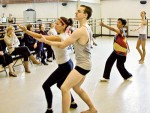Title
As the dancers stretch before class—bundled up in layers of tights, leotards, sweatpants and scarves—they all look so focused. The dancers are slowly easing their bodies into something: a leg extension, a pirouette, an arabesque. All are strong in their steps, seeming to defy the laws of gravity and speed with each lift or turn. Even when they stumble, they look graceful and elegant. It is awe-inspiring to watch, and one can only wonder what it takes to become that good.
Body
A new program now gives Juilliard community members a chance to witness, live and up close, exactly what it takes. The Open Studio-Classroom-Production program, which began in October, provides students, staff, and faculty members an opportunity to visit classrooms and dress rehearsals in the areas of dance, drama, orchestral and vocal music, and jazz. Initiated by the President’s Committee on Diversity and Inclusion, led by Alison Scott-Williams, the program was devised as a way for community members to experience the rehearsal and work process in areas outside of their own, and to foster a better understanding of how Juilliard could be a more inclusive community. Upcoming events include rehearsals of third-year drama productions of Scapin and The House of Bernarda Alba, a performance practicum with undergraduate singers preparing arias and art songs, and rehearsals of the upcoming New Dances program. (Community members can obtain a schedule from Scott-Williams and sign up by e-mailing aswilliams@juilliard.edu, indicating which event they would like to attend.)
In a recent interview, Scott-Williams, associate vice president for diversity and campus life, said, “When we expose ourselves to what we don’t know, there’s a learning that occurs, which encourages us to be more tolerant and patient—a very fundamental block of understanding diversity. This is really about your own self-understanding by stepping outside your own boundary.” She said that the idea for the open studio program arose from a lengthy conversation with voice faculty member Robert White, in which they both agreed they knew very little about things at Juilliard outside their own areas of expertise. After that, she spent about a year pursuing various division heads about the possibility of opening up their classrooms to people in the community, and honed in on what community members wanted the experience to be. The vast response was a desire to see and showcase process, rather than product. “We are very product-driven,” Scott-Williams said. “We read reviews, we see TV, and it’s always perfect. We aren’t about the process it took to make it appear that perfect.”
The schedule was devised with the goal of having two or three open studios per month so that, across an academic year, someone can observe something from all three divisions. Kathy Hood, administrative director of the Drama Division, said they “decided to offer two experiences a semester that would allow people to see a range of material and styles in the acting work, and expose them to our students in the second, third, and fourth years of training.”
Faculty members have also made themselves available to explain and discuss what is happening, so observers can get the most out of their experience. The Dance Division’s administrative director, Sarah Adriance, has been conducting an informal Q&A before and after each open dance class. Ballet teacher Alphonse Poulin, during his Level 5 ballet class on October 14, introduced himself to each guest and gave an outline of the day’s class syllabus, sharing quips along the way. “It’s all in the fondue,” he joked, expressing his belief that the fondue (a term used to describe a lowering of the body made by bending the knee of the supporting leg) is the foundation of ballet.
Modern dance teacher Carolyn Adams took time before and after her modern partnering class on October 16 to answer questions and share her methods of teaching and how they vary from Linda Kent’s (who teaches the class in the second semester). As Adams taught a section of Paul Taylor’s Aureole, she explained a bit of the choreographer’s personal history to help guests understand some of the movements; not only was Taylor a dancer, but also a painter and champion swimmer who was fluent in sign language. Students, enthused about having an audience, begged Adams to let them use the last few minutes of class to show guests an exercise in developing partners’ ability to land and catch simultaneously. (The exercise consisted of two students running in oppositional circles, full speed, and then jumping into the other’s arms.) Guests were overwhelmed with excitement. “I was actually very excited about this particular opportunity because, for whatever reason, I still hadn’t seen the Juilliard dancers in action,” admits Yassmeen Abdulhamid, administrative assistant to the provost and dean. “It was truly exciting to see them in their element. It was also great seeing a group of senior administrators and support staff come together to learn about what happens behind the classroom doors at Juilliard.”
The response from community members has been tremendous. Not only are people signing up to observe sessions, but many are making requests for things they would like to see on the calendar. Visitors have ranged from people with no knowledge of a particular division to those who are familiar and want to observe just to relive a part of their lives. Some guests just enjoy watching a particular faculty member teach, regardless of the subject. “It’s a mix,” says Scott-Williams.
The hope is that, once a session has been viewed, guests will begin to ask themselves how they fit in, or how what they just saw relates to what they do. Scott-Williams’s goal has been to inspire a sense of inquiry and tolerance in all of us as we begin to understand what happens in other areas of the Juilliard community. “It’s my hope for us,” says Scott-Williams, “to be able to be more tolerant and inclusive in our thinking and to have more reverence for what it takes to do what we do, across all areas.”





